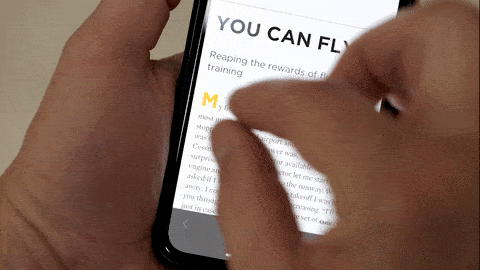Digital Publishing in 2022 | Get Started in 5 Easy Steps

Written by Matt Berringer
May 12, 2020
To put it mildly, COVID-19 has changed the way we do business. As of this writing, just about every major live event has been postponed, moved online or cancelled. Face-to-face meetings have been replaced with hours of video conferencing (pants optional). Business deals are being agreed to with virtual handshakes and business prospecting has been driven nearly entirely online. If you’re looking to adapt to this new world, digital publishing can help.
In a COVID-19 world, your business’s digital marketing is more important than ever. Everyone is trying to figure out how to approach it. For businesses who have relied on printed media this is an especially challenging time. Many salespeople, marketers, and publishers are now being forced to consider what an all-digital publishing world looks like.
Whether you’re looking to fully transition to digital or supplement a print edition, here are five steps you can take to get started.
- Decide what you’ll publish digitally
- Set your digital publishing (SMART) goals
- Define your target audience
- Define what matters to you and your target audience
- Determine how much you want to spend
1. Decide what you’ll publish digitally
Chances are, if you’re considering digital publishing you already have an idea of what you want to publish. However, take the time to consider your content. That can help determine the best digital format for it.
- Does the content already exist in some form (printed or otherwise) or hasn’t it been designed yet?
- If it is already laid out, do you want to replicate that design online or do you want to develop a more engaging reader experience?
- Is it a regularly published series or a one-off piece of content?
2. Set your digital publishing (SMART) goals
You know you want to publish something online but do you know why you want to publish it there?
What goals are you trying to achieve? Some examples are below but yours should be aligned with your company goals.
- Staying connected with your audience
- Educating audience members
- Growing your readership by X percent
- Increasing lead generation by X percent
- Racking up donations for your non-profit or alumni association
- Improving customer satisfaction and elevating your brand
These ideas can help you get started but the goals should be SMART in nature. That way you can easily determine how well your digital content performed and what adjustments you might want to make. It also makes it easier to report back to your leadership team on the progress you and your team is making.
3. Define your target audience
Who is the target audience for your content? Do you have an existing relationship with them or are you looking to drive new relationships?
If you have an existing subscriber base and you want to give them a secure digital option, your needs may be different than if you are looking to attract new readers via search engine traffic and social media.
Some digital publishing options like static PDFs are not ideal for search traffic. If organic reach is your goal, that may not be the best option for you. PDFs are also not the easiest or most elegant files to share via social media.
For more search-friendly options you could consider a website or something like PageRaft that allows for a more guided customer journey.
Additionally, think about how your audience is going to engage with your content. Studies continue to show mobile reading is on the rise and desktop reading is dropping. Honestly assess, will they be reading on a desktop, from a mobile device, or a healthy mix of the two?
Anybody who has ever pinched-and-zoomed their way through an important document on their phone can tell you, PDFs make that process very difficult.

If your audience is primarily engaging on mobile or you aren’t sure – it’s best to pick a solution that responds to the device on which it’s viewed. That makes for a better experience for your reader and a better image for your brand.
4. Define what matters to you and to your audience
Now that you know more about what you’re publishing, your goal for publishing it, and the audience you are publishing it for, it’s time to think about what matters to you and to your audience.
If you’re a digital publisher it might be important to be able have unique and engaging options for selling advertising. Expandable content, banner ads, belly bands, and more can be a part of your advertising toolkit with the right interactive content platform.
Other considerations for transitioning to digital publishing:
Would you like to retain ownership of your content?
Some digital content platforms assume ownership of your content in exchange for a lower/no-cost publishing option.
Would you like to have back issues available?
If so, would you like to have them developed in concert with your new issues so that readers can view old editions?
What is your timeline?
How quickly would you like to have your content created and published online? If the project is urgent, do you have time to learn new software or would you rather hand the project off to an experienced team?
Do you have design skills in house or do you need assistance?
Many platforms will sell you a license to design but don’t provide design resources after the sale. Some (but not many) vendors have an option that provides full design services and all clients have access to live support if needed.
How important is audience experience to your brand?
Often, brands will start with the lowest cost option to go digital. Often the lowest cost option is simply posting a static PDF. For some brands (far too many, if you ask us!), just having the content available is enough. For others, transforming that static content into awesome-on-any-device content is an opportunity to delight and wow their prospects or clients.
How important is accessibility?
Designing for optimal accessibility for your audience is a standard every company should aspire to. Aside from being the right thing to do, accessibility is especially important for public institutions and those wishing to avoid litigation or public relations complications.
Even when Section 508 doesn’t apply, many non-federal websites are still required to be accessible under other laws, such as Section 504 of the Rehabilitation Act of 1973, or state or local laws.
The issue of accessibility is an important one but it is also a tough one to quantify. It is a bit like the Wild West. There are a number of options available but there is currently no universal compliance body offering accessibility certification.
You can pay a web-accessibility firm to audit your content and provide a certificate. But that certificate doesn’t guarantee that the end product will achieve any specific level of accessibility (A, AA, or AAA).
The bottom line is that accessibility needs to be a part of your digital publishing plan. As there is no universal standard, different platforms can handle the issue in different ways. Talk with your digital publishing partner to develop a strategy for addressing this important segment of your audience.
What about security and access to your digital content?
Do you want your readers to freely access and share your content or would you prefer to restrict access via a digital rights management system. Do you want readers to be able to download a copy of your content?
How about analytics?
If analytics are important to your use case, traditional PDFs may leave you wanting more. Sure you can track downloads but that’s about it. For a deeper understanding of your reader’s experience and engagement, check out responsive or replica options. Many of these platforms offer better insights into how readers are engaging with your content.
To avoid any shady business practices like artificial click counts, make sure that you are getting third-party, independent analytics. You want to understand what the analytics are saying and trust that they are from a reliable third-party source.
5. Determine how much you want to spend
Now that you have a sense of the scope of your project, your goals, and the considerations around publishing digitally, it’s time to start thinking about how you are going to achieve all of those goals.
There are providers on every edge of the spectrum when it comes to digital publishing. The trick is balancing the needs you outlined above with your budget. If you just want to get something out at minimal cost, a free or lower cost option might be best. If you are looking to go beyond a basic experience and build an engaging and immersive digital one, explore the higher end options.
Below are a few digital publishing platforms to help get you started.
Free and lower cost:
Medium range options:
Higher end options:
The business world has changed dramatically in just a few months thanks to COVID-19. As many businesses look to make a transition to digital content, the competition for attention will only get stronger. If done well, digital publishing can be the X factor in helping you connect with your audience in meaningful ways. Following the steps outlined above will help your business stand out from the crowd.
Best of luck in your digital publishing journey and above all, stay safe!
If you’re interested in learning more about digital publishing, please let us know. It can seem complicated and overwhelming at first. However, with the right planning and partners you can be up and running digitally in a very short time.
Speaking of partners, our team is full of extroverts who are currently working from home and want to talk to someone! We’d love to chat. Get in touch with us here.